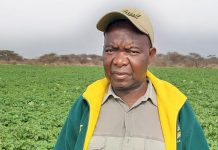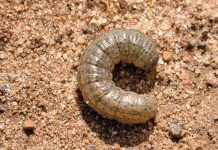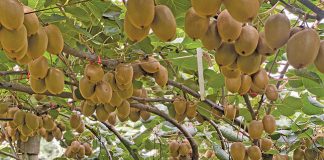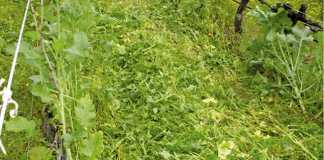
Sakkie Rust comes from a farming family in the Swartland, but he first ventured into a career in law and then launched a transport business before purchasing his first farm, located near Tulbagh, in 2001. Since then, this crop and livestock farmer has expanded his operations to 2 400ha of his own land, and another 1 450ha leased.
In 2020, Rust was a winner in the Protein Research Foundation’s Canola Yield Competition for realising an average yield of 2,16t/ha on 806ha.
Canola forms part of Rust’s three-year rotation system, which comprises two consecutive wheat crops, followed by canola and mixed cover crops for cattle pasture and silage. He plants wheat on 2 100ha, canola on 800ha, and mixed cover crops on 500ha.
Farming Ideology
According to Rust, his farming philosophy is anchored in the question: “How do I manage climate change with its more frequent dry spells?”
His basic answer has been to ensure that groundwater is available for plant growth for as long as possible.
He stresses that water-retention capability is directly linked to healthy soils.
“Healthy soils have an abundance of organic material and organisms. There’s a positive relationship between the presence of soil organisms, organic material in the soil, and, ultimately, the yields we get from the land. This is the foundation of all my farming practices, and we’re seeing the results in good yields and drought tolerance during dry seasons. Our organic soil content varies between 3% and 4,5%.”
Soil Preparation
When Rust bought his first farm, the general practice in the region at the time was to farm the top 100mm to 150mm of the soil. He bucked this trend by loosening the soil all the way down to 400mm.
“Land is expensive and I couldn’t continue expanding horizontally, so my plan was to expand into the soil,” he explains.
“ I figured that [in] deeper soils, crops would be encouraged to develop deeper and stronger root systems.
More roots in the soil would increase the biological mass, encourage soil organism activity, and assist in keeping moisture locked into the soil.
“We also started doing soil analyses up to 250mm, and then corrected with lime, gypsum and rock phosphate. I travelled to Australia to attend conservation farming research field days in the early 2000s, and learnt that it’s not just the elements in the soil that are important; it’s the relationships between them.”
Due to the general salinity problem in his soils, Rust avoids using chemicals that are high in salt content. Potassium chloride, for example, has a higher salt content than potassium phosphate, while urea is higher in salt than limestone.
“In both these examples, the products with higher salt levels are the cheaper options, but because we’re focusing on soil health, we prefer to invest in products that aid our long-term goals,” he explains.
Infestations of ryegrass and other weeds need to be addressed before a no-till or conservation management system can be implemented.
The effectiveness of modern products used to control ryegrass depends on their ability to bind directly onto the soil. “We therefore burn stubble to clear land before applying the herbicide directly onto the soil.
We also sometimes incorporate the herbicide application with an offset disc plough to make sure there’s an even distribution of chemicals in the topsoil layer.”
After loosening the soil and correcting any imbalances, Rust avoids any further activity that could lead to soil compaction. This also applies to his livestock management.
“We have a policy of no animals on wet land. I prefer cattle, as they’re top grazers and leave a lot of organic material in the form of stubble. We use high-density grazing on the paddocks where mixed cover crops are established, which translates into 10 head of cattle per hectare for a two-week period in our system.”
Rust plants mixed cover crops that consist mainly of forage radish, which has a strong root system to loosen soil; lupines, vetch and peas, which fix nitrogen; and oats, which suppresses fungal diseases in other crops and has a high volume of palatable biomass. He also plants faba beans to incorporate into his feedlot rations and oats for silage.
The animals contribute to soil health by trampling the stubble well into the soil. This maximises its contact with soil particles and organisms, setting up the symbiotic cycle where organic material is broken down and nutrients are released for plant growth. The cattle also trample the stubble into a dense mesh, which lessens the effect of their hooves on soil compaction.
Challenges in the Swartland
Canola is integral to Rust’s rotation system, as it is a natural soil fumigant. In addition, canola prices have been favourable over the past few years; there is only one major buyer, and its interests and those of the farmers are clearly interlinked.
“In the Swartland, break-even can be achieved with a yield of 1,35t/ha, and our farms seem to average above 1,8t/ha,” says Rust.
Nevertheless, the Swartland’s canola growers face a number of unique challenges.
“Winter tends to be too short and September too hot. Canola is an opportunistic grower, so with the correct conditions, it’ll keep growing and increasing yield.
Farmers have to aim for even germination; uneven germination and uneven ripening result in yield losses.
“This means that it’s essential to get your seeding timing, seed depth and fertiliser dosage all optimal in order to exploit the cool growing conditions when they’re available.
Plant too late, and your growth season will be too short; plant too deep, and you might suffer secondary dormancy if light, unseasonal rain is followed by hot, dry weather,” says Rust.
He believes that deep, loose soils with high levels of soil organisms, which work in tandem with the plant to develop strong, deep root systems, mitigate these challenges.
“We plant shallow, and keep the fertiliser away from the seed to ensure it has maximum effect on growth only after germination. We’ve modified our planters to allow for an additional application of liquid biological feed aimed specifically at increasing soil organism life.
“We only plant short-growth canola cultivars due to the short growing season.”
Seed Size Matters
In Rust’s opinion, the quality of canola seed available to local farmers can be improved.
“I’ve seen the seed used in Australia, and what we get in South Africa isn’t of the same quality,” he says.
He believes there is a correlation between size and quality, and South African farmers have access only to small seeds, generally between 1,2mm and 1,6mm in diameter.
“Large seeds germinate better, so this could be an improvement for all our growers, and is something to explore.
”As seed is expensive, Rust has been experimenting with planting density for optimal yield. “The industry norm is between 3kg seed/ha and 5kg seed/ha, whereas we’re currently planting 1,8kg/ ha, which gives me, on average, 25 plants/ m² to 35 plants/m².
I feel that the lower plant density encourages the development of stronger plants, which seem to be more resistant to disease and drought. In addition, there is more root mass below the soil, which adds to canola’s drought tolerance.
“As the plant is opportunistic, I’ve had break-even yields with as few as five plants/m2.”
Harvesting is done via swathing at a height of 150mm.
“We also roll the windrow to make it more compact. It takes about a week longer to dry, but at least it doesn’t blow away in the wind.”
Responding Well To Nutrition
Rust recalls that 2015, 2017 and 2019 were drought years.
“In 2015, I was concerned about canola’s ability [to thrive] under drought conditions, so we only planted wheat, and that year I made my best wheat profit ever.
However, I observed how well canola was doing on other farms in the area, so decided to plant canola every year from then on.
“I’ve seen at first hand how canola can reward you with good yields if you give it the necessary nutrition. In 2016, we obtained a yield of more than 4t/ha in certain camps, and in 2018 a yield in excess of 3t/ha.
We also found that canola improves our wheat yield by 15% in the first year of our wheat cycle.
“The 2020 season is a good example of what can happen when everything works together. We planted early, before the Easter weekend, and thus had a long growing season.
We were also blessed with a cool September. The result was our winning average yield of 2,16t/ha over 806ha.”
For more information, email Sakkie Rust
at [email protected]













